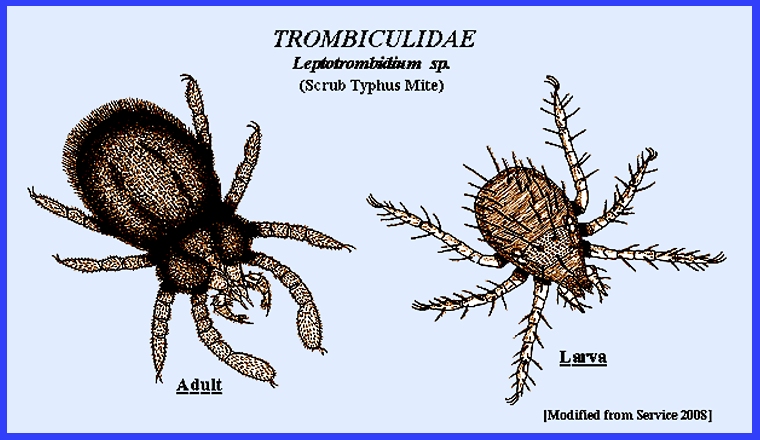File: <scrubtyphus.htm> <Medical
Index> <General Index> Site Description Glossary <Navigate
to Home>
|
SCRUB TYPHUS (Contact) Please CLICK on
Image & underlined links for details:
LIFE CYCLE (See Diagram) Trombiculid mites have a complex life cycle and different
terms have been applied to the developmental stages, but the terminology used
by Service (2008) is applied as follows:
Adults of this group are not parasitic but rather inhabit the soil
where they feed on other arthropods.
During warm weather a female mite may lay up to five eggs daily on
organic material located on the soil surface, in field grasses, etc. "Deutorum" larvae with six legs
emerge but initially do not leave the egg shell (the
"Deutovum"). Activity
begins about a week later when the mites swarm all over the soil and
grasses. They try to attach to
mammals and birds as well as to people with which they come into
contact. They gather around soft and
moist areas of a host. The larvae then penetrate into the skin, injecting saliva
that destroys cells. They feed on
lymphal fluid instead of blood. The continued
release of saliva then results a nasty skin reaction. Some species spend a whole month on a
host, but the vectors of Scrub Typhus remain on a host for only
about a week. When fully fed the
larvae exit the host and drop to the ground where they bury into the soil or
under leaf litter, etc. There they change
into a "Protonymph," which moults within week and gives rise to a
"Deutonymph" with eight legs.
The deutonymphs like the adults feed for a couple of weeks on
arthropods in the soil. Feeding stops
and the nymphs change into a "tritonymph" that moults after about
two weeks giving rise to the adult stage.
The total life cycle generally takes up to two months, but sometimes
8-10 months are required. Because nymphs and adults feed on other arthropods they
require habitats where there are sufficient arthropods present to sustain
them. Service (2008) noted that ideal
habitats are often produced when vegetation is cleared for agriculture or
wood products. A larva will remain on only one host during its lifetime,
so transmission does not occur between people by them. Rather the nymphs and adult mites are
vectors. Transovarial transmission among
mites insures virus persistence in their population (See Service 2008 for details
about transmission). CONTROL Repellents have been recommended for control, as it is
difficult to effectively attack the mites.
Once principal habitats among the vegetation are discovered these can be
sprayed with insecticides or even destroyed by burning. = = = = = = = = = = = = = = = = = =
= = Key References: <medvet.ref.htm> <Hexapoda> Azad, A. F. 1986. Mites
of public health importance and their control. WHO/VBC/86.931. Geneva, Switzerland Frances, S. P., D. Watcharapichat, D. Phulsuksombati
& P. Tanskul. 2000. Transmission of Orientia tsutsugamushi, the aetiological agent for scrub typhus, to co-feeding
mites. Parasitology 120: 601-607. Hengbin, G., C. Min, T.
Kaihua & T. Jiaqi. 2006. The foci of scrub typhus and strategies of
prevention in the spring in :ingtan Island, Fujian Province. Ann. New York Acad. Sci. 1078: 188-196. Kawamura, A., H. Tanaka & A. Tamura
(eds.). 1996. Tsutsugamushi Disease: an Overview. Tokyo Univ. Press. Matheson, R. 1950. Medical Entomology. Comstock Publ. Co, Inc. 610 p. Ogawa, M., T. Hagiwara, T. Kishimoto et al. 2002. Scrub typhus in Japan: epidemiology and clinical features of
cases reported in 1998. Amer. J. Trop. Med. & Hyg. 67: 162-65. Roberts, S. H. &
J. H. Zimmerman. 1980. Chigger mites: efficacy of control with two pyrethroids. J. Econ. Ent. 73: 811-812. Sasa, M. 1961.
Biology of chiggers. Ann. Rev.
Ent. 6: 221-244. Service, M. 2008.
Medical Entomology For Students.
Cambridge Univ. Press. 289 p Strickman, D.
2001. Scrub typhus. IN:
The Encyclopedia of Arthropod-Transmitted Infections of Man and
Domesticated Animals. CABI, Wallingford, pp. 456-62 Takahashi, M., M. Misumi, H. Urakami et
al. 2004. Mite vectors (Acari: Trombiculidae) of
scrub typhus in the new endemic area in northern Kyoto,
Japan. J. Med. Ent. 41: 107-114. Takahashi, M., M. Murata, H. Misumi, E. Hori, A. Kawamura. & H. Tanaka. 1994.
Failed vertical transmission of Rickettsia
tsutsugamushi
(Rickettsiales: Rickettsiaceae) acquired from rickettsemic mice by
Leptotrombidium pallidum (Acari: Trombiculidae). J. Med. Ent. 31: 212-16. Traub, R. & C.
L. Wissemann. 1968. Ecological considerations in scrub typhus.
1> Emerging concepts. Bull. WHO
39: 209-218. Traub, R. & C. L.
Wissemann. 1974. The ecology of chigger-borne
ricksettsiosis (scrub-typhus). J.
Med. Ent. 11: 237-303. Walter, D. E. & H.
C. Proctor. 1999. Mites: Ecology, Evolution &
Behavior. Univ. of New South Wales
Press, Sydney. |
